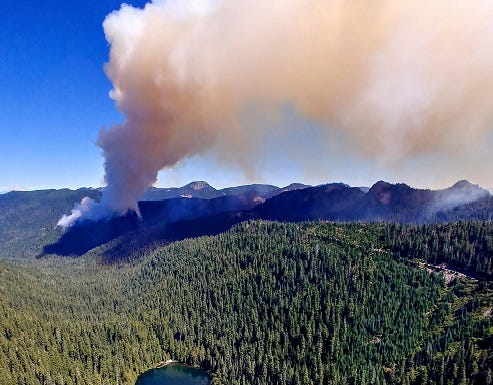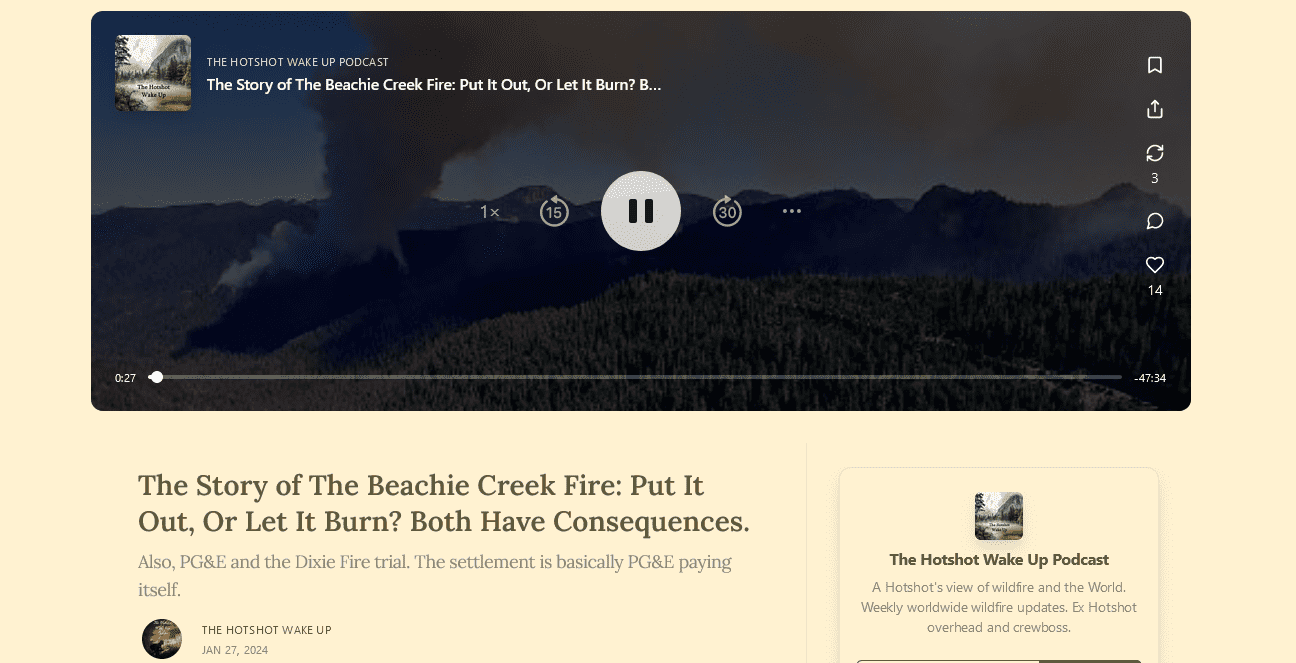OK, I get it.. permitting reform is not everyone’s favorite topic. So I thought I’d highlight some interesting stuff on Wildfire, before I get back to permitting.
The Hotshot Wakeup Person had a couple of interesting items on Substack. If you’re interested in this stuff, please consider subscribing to The Hotshot Wakeup Substack. I always learn something from his posts and often I find myself laughing out loud as well.
The Story of The Beachie Creek Fire: Put It Out, Or Let It Burn? Both Have Consequences.
I know some TSW readers are very interested in Oregon fires. I like how Tim explains to us non-Fire folks some of how pre-planning is done and MIST techniques and what I like best of all is that he can see both sides. I do think we get better reporting from people who can understand different points of view. Anyway, I recommend it. The PG&E part is a little depressing, especially since, as I’ve pointed out before, the Princeton study say to meet net zero by 2050:
“The current power grid took 150 years to build. Now, to get to net-zero emissions by 2050, we have to build that amount of transmission again in the next 15 years and then build that much more again in the 15 years after that. It’s a huge amount of change,” said Jenkins.
And PG&E can’t afford to bury the lines they have.. oh, well.
Here’s his summary of the podcast contents.
- The story of the Beachie Creek Fire in Oregon.
- Multiple lawsuits on how the fire was handled by the Forest and $1B demanded from the power company.

The Beachie Creek Fire - MIST tactics V.S. full suppression. Safety V.S. engaging. What’s the cost in the end?
- PG&E come to a settlement on the Dixie Fire trial.
- Did PG&E just pay itself as a result? Where does the money actually go?
I’ve never heard anyone report on this PG&E stuff before..
Team Prescribed Fire Tabletop Exercise
A lot of Region 5 folks were involved in the large-scale Team Prescribed Fire out on the Stanislaus National Forest last year, as California’s weather allowed for it. It was a live-action “sand table” that a lot of people in the D.C. office were watching. A full ICP was brought in, caterers, loads of crews, and drones.
A lot of kinks were worked out during this operation. It was new to a lot of those involved, and things like overtime limits, R&R issues, people on crews timing out before others, and more arose. It wasn’t expected to go off without a hitch, and plenty was learned from this operation. Now they can implement those lessons learned going forward.
Just last week, the Forest Service put out their Strategy to Expand Prescribed Fire Training in the West. This new report lines out what federal firefighters, contractors, NGOs, tribes, and tech folks can expect as policy and money flow into prescribed fire across the nation.
The announcement, made by Alex Robertson, Director of Fire and Aviation Management, looks to expand the National Interagency Prescribed Fire Training Center into the Western United States.
The National Interagency Prescribed Fire Training Center is currently operating out of Florida; however, this new policy and working group aims to expand its operation and reach into the western United States.
The three key elements for building out PFTC-West include:
- increasing staffing
- establishing focus groups to explore new curriculum and prescribed fire modules, including unmanned aircraft systems (UAS)
- expanding the PFTC Steering Committee.
The current committee is comprised of national leadership from the USDA Forest Service, DOI agencies, TNC, the Florida Forest Service’s State representative for the National Association of State Foresters, and a Tall Timbers Research Station representative. The committee is looking to add representatives from the western states into the mix.
While there are many stated goals, one is to increase training and qualifications for prescribed fire across the West and bring in operators from the private, state, and local sectors.
They are also looking to create a new “drone division” in this expansion, bringing on new tech, pilots, and operators.
The National Interagency Prescribed Fire Training Center is currently operating out of Florida; however, this new policy and working group aims to expand its operation and reach into the western United States.
The three key elements for building out PFTC-West include:
- increasing staffing
- establishing focus groups to explore new curriculum and prescribed fire modules, including unmanned aircraft systems (UAS)
- expanding the PFTC Steering Committee.
The current committee is comprised of national leadership from the USDA Forest Service, DOI agencies, TNC, the Florida Forest Service’s State representative for the National Association of State Foresters, and a Tall Timbers Research Station representative. The committee is looking to add representatives from the western states into the mix.
While there are many stated goals, one is to increase training and qualifications for prescribed fire across the West and bring in operators from the private, state, and local sectors.
They are also looking to create a new “drone division” in this expansion, bringing on new tech, pilots, and operators.
**************
So what does this all mean for the future?
It means lots of new positions, career paths, large-scale Team ignitions, completely new divisions for UA S platforms, pilots, and operators, and hopefully, plenty of good quality acres burned across the American West.

Lots of good stuff here Sharron – thanks for reporting on this. It’s about time we make good on scaling up prescribed fire IMTeams just like we do suppression teams. We told Congress during the 2000 National Fire Plan build up ‘if you just give us more money for hazardous fuels we can bend the suppression cost curve down…. we know how that worked out 25 years later ….
The caveat to the success of a plan like this is to take off the NWCG training and qualifications handcuffs…. not entirely, but the new multi million dollar training contract that was awarded to review and update NWCG training, experience and qualifications should be able to retool our largely outdated esoteric, biased system…
There are great operators out there in the feds and non-Feds alike. The current model has the pipeline so damn constricted most people give up trying to get qualified in a system that has out used its usefulness; it’s now an impediment to expanding scope, scale and time. I’ve also heard horror stories about REDCARD committees who are biased against ’final evaluators’ and trainees who hold long ago resentments in an effort to settle old scores…we have a very broken system of who gets qualified when and who doesn’t and we have little time to waste.